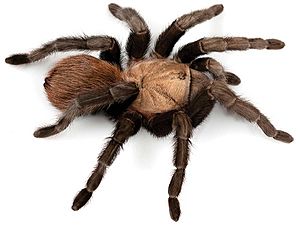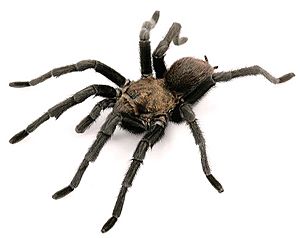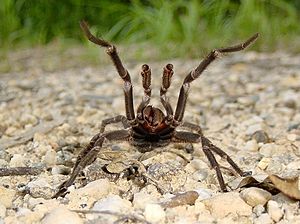Texas tan tarantula facts for kids
Quick facts for kids Texas tan tarantula |
|
|---|---|
 |
|
| Female | |
 |
|
| Male | |
| Scientific classification | |
| Synonyms | |
|
The Aphonopelma anax, also known as the Texas tan tarantula, is a type of spider. It belongs to the tarantula family, called Theraphosidae. You can find this spider in southern Texas and northern Mexico.
Contents
Discover the Texas Tan Tarantula
The Texas tan tarantula is one of the biggest tarantulas in the United States. When fully grown, its legs can spread up to 5 inches wide. Some female tarantulas can even reach a 6-inch leg span!
Like many tarantulas, it grows very slowly. It lives for several years before it becomes an adult. Female tarantulas are much bigger and heavier than males. Males often have longer legs but a smaller body. When male tarantulas are grown, they have special bulbs on their pedipalps. They use these for mating.
What Does the Texas Tan Tarantula Look Like?
As its name suggests, the Texas tan tarantula is mostly tan and dark brown. It looks a bit like another Texas spider, the Texas brown tarantula. However, the Texas tan tarantula is usually much darker.
This tarantula has special hairs called urticating hairs. Many tarantulas from the "New World" (North and South America) have these. But unlike some other spiders, it does not have hairs for making sounds on its chelicerae.
Where Do Texas Tan Tarantulas Live?
The Texas tan tarantula lives in southeastern Texas. They have been seen in Cameron County and Kleberg County. You can also find them in Northern Mexico.
These areas have a dry climate. The tarantulas live in grasslands and shrub forests. They can even be found in cities!
Texas Tan Tarantula Homes
Most tarantulas, including this one, do not build a typical spider web. Instead, they live in burrows lined with silk. A burrow is like a small tunnel in the ground.
Sometimes, the tarantula digs its own burrow. But often, it will find an existing hole and make it its home. These homes can be in dead trees, empty burrows made by small animals, stacks of wood, or natural cracks in the ground.
Life Cycle of the Texas Tan Tarantula
Female Texas tan tarantulas can lay hundreds of eggs at one time. The female weaves a special egg sac to hold her eggs. She guards this egg sac very carefully inside her burrow. She also turns the egg sac often. This helps the eggs grow properly.
The eggs hatch after a few weeks. The baby spiders, called spiderlings, might stay with their mother for a while. Then, they leave to find their own way in the world.
How Long Do They Live?
Female Texas tan tarantulas are known to live for a very long time. Some have lived up to 40 years! Scientists are still studying them, so they might even live longer. Male tarantulas do not live as long. They usually live only about two years after they become adults.
Behavior of the Texas Tan Tarantula
How Do Texas Tan Tarantulas Act Around People?
The Texas tan tarantula is usually calm and avoids people and larger animals. Because they are so gentle, people sometimes keep them as pets. The Texas brown tarantula is also a popular pet.
If a Texas tan tarantula feels threatened, it will defend itself. It uses its back legs to kick off some of its urticating hairs. These hairs can fly towards whatever is bothering it. If the hairs touch your skin or sensitive areas like your eyes or nose, they can cause a mild rash or swelling. Some people might have an allergic reaction, which can make the symptoms worse. These reactions can last from a few hours to several weeks.
Besides kicking hairs, the tarantula might also stand up on its back legs. It will raise its front legs in a "threat posture." This is meant to scare away anything that might be a danger.
How Do Texas Tan Tarantulas Mate?
Texas tan tarantulas follow the usual mating steps for tarantulas. When a male tarantula becomes an adult, it builds a small web. This web helps it get ready to find a mate. The male then rubs its belly on the web to release its semen. It then picks up the semen with the tips of its pedipalps. The semen stays ready until the male finds a female.
When a male finds a female, they "talk" to each other. They usually tap their legs in a special rhythm. This helps them know they are the same kind of spider. If the female is ready to mate, the male will come closer. He lifts her upper body and then puts his pedipalps into her reproductive organ. This organ is on her abdomen.
After mating, the male quickly leaves. This is to avoid being eaten by the female. Females usually do not attack the male after mating, but it can happen sometimes.
See also
 In Spanish: Aphonopelma anax para niños
In Spanish: Aphonopelma anax para niños


